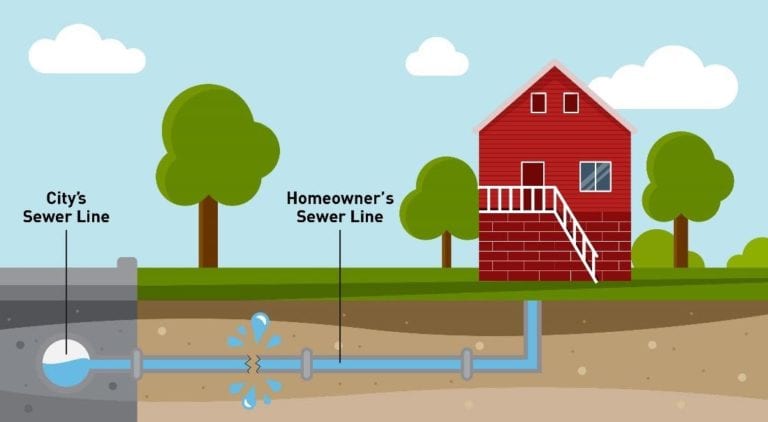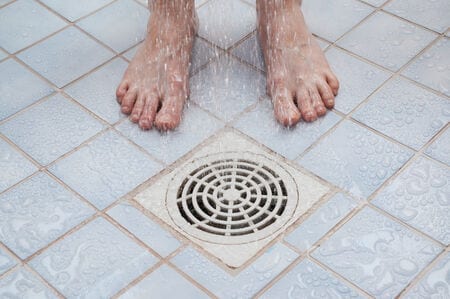Clogged sink drain? Or is it a much bigger issue…?
Sewer line backups can spell big, expensive trouble if they are not taken care of. A sewer line back up in a finished basement can cause damage in the range of $10,000 to $30,000 or more. Learn the signs and symptoms of a serious drain issue and how to make sure you don’t experience a costly, smelly sewer line backup.
As a homeowner, you’re responsible for any problems with your sewer line. Here’s how to tell if there’s an issue – and what to do about it.
Even if you’ve owned your home for years, this might be the first time you’ve heard anything about being liable for issues with your sewer line.
The sewer line is the pipe that carries out the wastewater from all the pipes within your home to the municipality’s main sewer line. You knew all that wastewater had to go somewhere, right? Your sewer line is underground, and the only way to see inside it is to have a camera inspection done by a professional.
When our drains slow down, we tend to think it’s a surface-level problem. Perhaps we attack it with a corrosive cleaner and hope for the best, not realizing that corrosive cleaners, even the ones most commonly used, can permanently damage your pipes and should be avoided. And, the problem might lie way beyond your sink.

Here are a few signs that something might be wrong with your sewer line:
Your floor drain backs up.
If you have a utility room, laundry room, or any lower-level area with a floor drain, a backup is a strong indicator that something is amiss with your sewer line.
The drain in your basement shower or tub is slow.
Ever taken a shower in the basement bathroom and found yourself standing in a wading pool? Don’t ignore the problem.
Water pools when you do laundry.
Washing machines demand a lot of water, and if you notice drains backing up or pooled water while you’re running the machine, it could be an issue with your sewer line.
Your toilets gurgle.
It’s easy to dismiss a gurgling sound as a sign of an older toilet or excess use, but it is often not a problem with the toilet at all – it’s a problem with the sewer line.
Multiple (or all) sink, shower, and tub drains in your home are slow to drain.
If just one sink is slow, it might be a localized clog. But if all the drains are slow, it can indicate a backup in the sewer line.

If you’re noticing any of these symptoms, don’t delay. It’s important to tackle a sewer line problem as early as possible before major damage is done. As a homeowner, it’s nearly impossible to verify a sewer line issue yourself, and that’s why it’s so important to seek expert help. Trained technicians from a reputable company like Bonfe can send special cameras into your sewer line to see what’s going on.
Sewer line problems can be caused by tree roots that pop through, excess sand deposits, and cracks or shifts from age or disruption (the latter is especially likely if any construction has taken place on or near your property).
A camera inspection by a qualified Bonfe technician will reveal what is causing your sewer line backups and what the options are to resolve it. The good news: while sometimes digging up your yard and replacing the entire sewer line with a new one is called for, there are lots of other options that can provide a short term or long-term remedy.
Grinding or water-jetting.
When tree roots growing through the sewer line are causing backups, special tools can be inserted into the sewer line to blast through the roots. Sometimes high-pressure water jetting is used, and other times a grinding blade is used. While this approach can quickly get your drains flowing, it is a temporary solution. A good sewer line should never backup.
“Spot” Repair or Replacement.
If just one area of your sewer line is broken or shifted, it’s often possible to dig out and replace just the broken section. Alternatively, sometimes a new liner can be inserted into the existing sewer line, resurfacing just the broken section.
Re-lining.
If there are multiple breaks or cracks in your sewer line, a liquid liner can be inserted into your sewer, then hardened using special heat technology. The new liner is durable and smooth, providing a long-term solution. Re-lining avoids having to dig up your yard.
Replacement.
In some cases, the best solution is to have the entire sewer line dug up and replaced. While disruptive, full replacement provides a long-term solution to sewer line issues.

